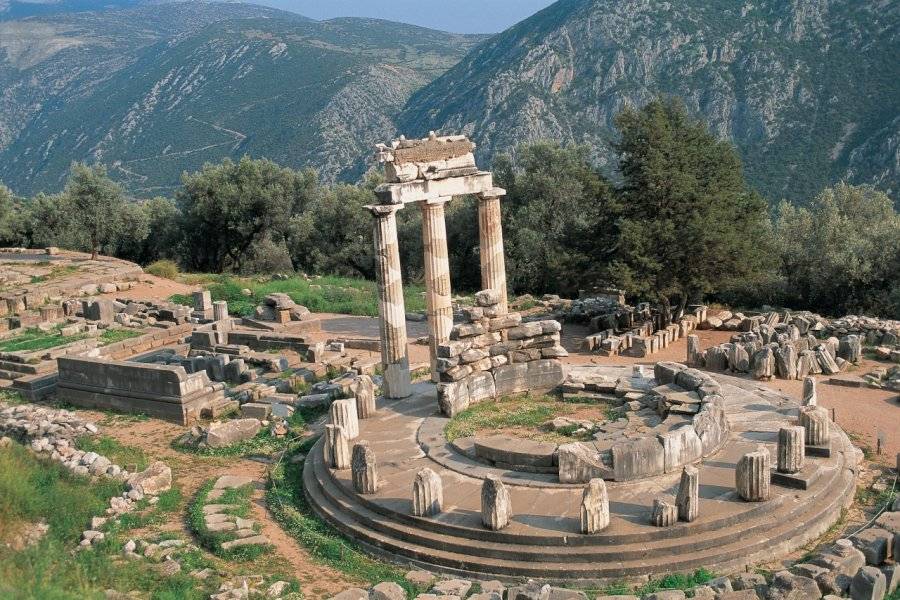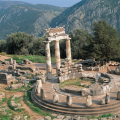DELPHI ARCHAEOLOGICAL SITE
Ancient sanctuary of Apollo, listed as a UNESCO World Heritage Site: numerous remains, grandiose views, but steep slope.
This 51-hectare site (Αρχαιολογικός Χώρος Δελφών/Archaiologikos Choros Delfon) is a Unesco World Heritage Site and part of Mount Parnassus National Park. An ancient sanctuary dedicated to Apollo, it is one of Greece's most beautiful archaeological sites. It boasts grandiose landscapes, but requires a good level of physical fitness for the visit (allow 3 hours with good shoes, a hat, water and warm clothing in winter). It lies between 490 and 660 m above sea level on the flank of Mount Cirphis (1,503 m), offering sweeping views over the Plistos valley, the Itea-Chrisso sea of olive groves and the Gulf of Corinth, while above it dominate the two peaks of Phedriades ("the Shining Ones"), at 700 m above sea level, and Mount Parnassus, at 2,460 m. It was in this enchanting setting that the cult of Gaia, the Mother Goddess, developed during the Mycenaean period. According to mythology, Gaia gave birth to the serpent Python, who guarded the oracle of her sanctuary here. But Apollo, who resided on Mount Parnassus, killed Python and appropriated the oracle to guide mankind. This led to the institution of the Pythia in Antiquity: a pure woman chosen for her powers of divination, whom Mediterranean pilgrims came to consult about their future. The ancients also considered Delphi to be the Omphalos: the "navel", the center of the world.
Roman agora and sacred way. The site is divided into three zones: the sanctuary of Apollo proper, the Pythian Games stadium on the heights, and the sanctuary of Athena Pronaia, slightly to one side. The center of the sanctuary is the temple of Apollo, halfway up the slope. To get there, you must first pass in front of the Roman agora (4th century AD). This market square still contains a dozen or so columns of a gallery that housed stores where pilgrims bought offerings to leave along the way, as well as a goat to sacrifice in front of the temple. Then begins the sacred path. This 250 m-long paved path was created in the 7th century B.C. It is lined with buildings from different periods, most of them treasures or votive monuments donated by the cities. The first of these is the exedra of the kings of Argos (c. 370 BC): two hemicycles on either side of the sacred way, housing statues of the heroes of battles won by Argos against Sparta. Then, around the first bend, some twenty "treasuries" are concentrated: buildings in the shape of small temples that housed the precious goods of the cities and where pilgrims deposited offerings.
Treasury and portico of the Athenians. At the first bend in the sacred road, the Athenian treasury enjoys the best location and is the only one to have been reconstructed by archaeologists. This Doric building (6.5 x 9.7 m) in Paros marble was erected after the Battle of Marathon, in 490 BC. It is framed by the remains of the bouleuterion (above, right), where the Sanctuary Council sat, and by a copy of the conical sculpture of the Omphalos (below, left), which symbolized the center of the world. Along the sacred path, on the left, are the rock of the Sibyl (site of archaic prophecies from the Mycenaean era), the base of the Naxian column (surmounted by a sphinx, visible in the museum) and the Athenian portico (5th century BC). This 26-m-long gallery, three of whose eight columns have been raised, was used to display offerings from Athens after its naval victories. It backs onto the "polygonal wall", an 83 m-long retaining structure of elegantly fitted polygonal stones on which the terrace of the Temple of Apollo rests. Opposite the Sybil rock, on the right-hand side of the sacred path, is a primitive religious area where rituals re-enacting Apollo's murder of Python took place.
Terrace of Apollo's temple. The Sacred Way leads to the heart of the sanctuary, with its magnificent views. On the right, the "Carrefour des Trépieds" was the site of the most beautiful offerings, in the form of a tripod, the symbol of Pythia. Here stands a replica of the "serpentine column", the original of which has been installed in Istanbul since the 18th century. It was adorned with the Tripod of Plataea, donated by the coalition of Greek cities after their victory over the Persians at Plataea, near Thebes, in 479 BCC. Opposite, the temple is preceded by the remains of two buildings: on the left, the altar of Apollo, where animals were sacrificed, and, on the right, the Pillar of Prusias, which supported an equestrian statue of Prusias II, king of Bithynia (east of Istanbul) in the 2nd century B.C. The temple (23.8 x 60.3 m), which is off-limits to visitors, retains six Doric columns, which were raised in 1940. This is the fifth version of the building erected in the 4th century BC, the previous ones having been destroyed by fire and landslides in the Phedriades. The pediment featured the maxim "Know thyself", attributed to Apollo. Inside were two sacred objects: the Omphalos stone (preserved in the museum) and a statue of Dionysus, who "replaced" Apollo in winter. The temple was also home to the Pythia, who, in the fumes of sulfur, would enter a trance to question Apollo (or Dionysus) and give an enigmatic answer to each pilgrim.
Theater and stadium. The path north of the temple of Apollo runs alongside the Ischegaon ("wall that holds back the earth"), where the breathtaking statue of the Aurige, on display in room 13 of the museum, once stood. The well-preserved theater was remodeled in the 2nd century BC. Today off-limits, it could accommodate 4,500 spectators, notably for the artistic events of the Pythian Games in honor of Apollo, originally held every nine years: zither, flute, songs, tragedies and comedies. Then climb 400 m along the theater to reach the stadium. Stop off along the way to admire the panorama. Located at the top of the sanctuary, Delphi's ancient stadium is one of the best preserved in Greece. Built in the 4th century BC, it features a 178 m-long arena and stands added by the Romans for around 6,500 spectators, one in marble, of which a few rows remain to the south, the other carved out of the rock at the foot of the Phedriades. It was in this enclosure that the sporting events of the Pythian Games were held: stadion (stadium-length race), hoplitodromos (arms and armour race), long jump, discus throw, pancrace (a mixture of wrestling and boxing), and so on. Then head back in the opposite direction, leaving the main site and heading southeast for 800 m.
Towards the sanctuary of Athena Pronaya. About 200 m after the ticket office, you can do as the pilgrims of antiquity did: pause at the foot of a large rocky fault, at the Castalie fountain. This fountain owes its name to a nymph who found refuge here to escape Apollo's advances. The road then overlooks the remains of the gymnasium, below and off-limits to visitors. Dating from the 4th century BC, remodeled by the Romans in 120 AD and later converted into a monastery, this long building and its outbuildings were used to train athletes for the Pythian Games. The tour ends at the small sanctuary of Athena Pronaya. Originally dedicated to Gaia, it was consecrated to the Goddess of Wisdom from 650 BC onwards, and owes its epithet to the fact that it was located "before the temple" (pro naos) of Apollo for pilgrims arriving from Athens. Leave the road and follow a path that zigzags through olive groves to the sanctuary terrace. Little remains of the Temple of Athena (c. 360 B.C.), used as a storage area for columns and carved blocks. On the other hand, archaeologists have found three of the twenty columns of the 4th-century BC tholos (circular temple) in Paros marble, where Gaia was worshipped. Nearby are the walls of the Massaliotes treasury, built around 510 BC by Phocaean settlers from present-day Marseille.
Did you know? This review was written by our professional authors.
Members' reviews on DELPHI ARCHAEOLOGICAL SITE
The ratings and reviews below reflect the subjective opinions of members and not the opinion of The Little Witty.








Pour moi, c'est mon plus beau souvenir de mon voyage en Grèce, le lieu que j'ai préféré.. et un des moins fréquentés.
A faire absolument.